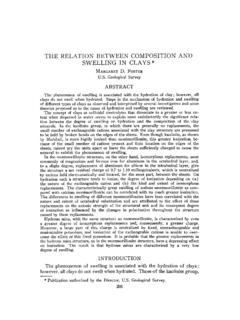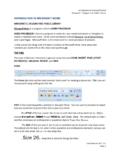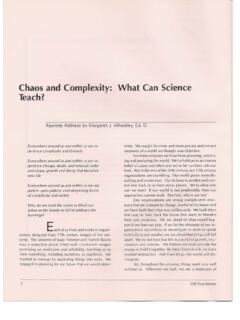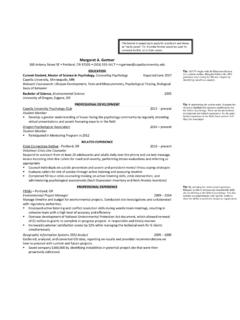Transcription of margaret sinclair - unhcr.org
1 SummaryThis paper reviews the rationale for education in situations of emergency and crisis, and the basic principlesfor emergency education. It examines how these principles were reflected in some recent emergencies. The intense 1990s debate on education kits is revisited. A final section examines the implications of thestudy for preparedness and for education in emergency include the psychosocial needs of children and adolescents affected bytrauma and displacement, the need to protect them from harm, and the need to maintain and develop studyskills and disseminate key messages such as how to avoid HIV/AIDS, landmine awareness, environmentaleducation and education for peace and citizenship. All these are aspects of the rights of the key principle for education in situations of emergency and crisis is rapid response, using a community-based approach, with capacity-building through training of teachers, youth leaders and school managementcommittees.
2 Education should support durable solutions and should normally be based on the curriculumand languages of study of the area of origin. Survival and peace-building messages and skills should be incorporated in formal and non-formal education. Programmes must progressively promote theparticipation of under-represented groups, including girls, adolescents and persons with disability. Ongoingrefugee programmes should develop procedures for rapid response to the needs of newly arriving refugeechildren and include the strengthening of institutional commitment and preparedness, in terms ofpolicy, staffing arrangements and training, and funding. There should be no question that UNHCR has avital role to play in the education sector, along with its UN and NGO partners, since the internationalcommunity provides it with the physical and human resources for a strong field presence in refugee,returnee and some other situations.
3 Inter-agency cooperation, strengthened by the year 2000 WorldEducation Forum and Inter-Agency Consultation in Situations of Emergency and Crisis, can help emergencyeducation fulfil its humanitarian and peace-building 1 Education in Emergenciesmargaret sinclair1 EDUCATION IN EMERGENCIES1 See the Forum s declaration, Dakar Framework for Action Education for All: Meeting our Collective Commitments (World EducationForum, 2000a), and the Thematic Studies published for the Dakar meeting. The Framework includes a pledge to meet the needs ofeducation systems affected by conflict, natural calamities and instability, and to conduct educational programmes in ways that promotemutual understanding, peace and tolerance. A follow-up Inter-Agency Consultation on Education in Situations of Emergency and Crisis washeld in Geneva in November has commissioned parallel research papers on the themes of the quality of refugee education (Brown, 2001, Williams, 2001) andeducation for peace (Sommers, 2001).
4 3 UNHCR s recent Briefing Paper on The Education Sector in UNHCR s Programmes, in its section entitled Emergency educational response ,notes the need for inter-agency cooperation, institutional preparedness, standby staffing arrangements, emergency supplies of learning andteaching materials, a phased strategy, and work with refugee and local communities and educators to define needs and design appropriateresponses (UNHCR, 2000a).IntroductionThe end of the Cold War did not mean the end of conflict and population displacement. Many of thecountries which gained (or regained) their independence in the latter decades of the twentieth century aremulti-ethnic in nature and have not yet developed stable systems of governance. The 1990s saw numerousconflicts with an ethnic dimension, which led to suffering and displacement for millions of children and youngpeople, often under horrific circumstances. Their lives were disrupted and their education abruptly has coincided with the enhanced awareness of children s needs and rights, following nearly universalratification of the 1989 Convention on the Rights of the Child.
5 Gra a Machel s Report on the Impact ofArmed Conflict on Childrenhighlighted the needs for education in emergency situations (Machel, 1996).These needs were reiterated at the World Education Forum held in Dakar in April is increasingly viewed as the fourth pillar , or a central pillar , of humanitarian response,alongside the pillars of nourishment, shelter and health services (Norwegian Refugee Council et. al., 1999: 26; Midttun, 2000a: 3 4; ICWAC, 2000: 9). Children are vulnerable and dependent, and they aredeveloping, not only physically but mentally and emotionally. The sudden and violent onset ofemergencies, the disruption of families and community structures .. deeply affect the physical andpsychological wellbeing of refugee children (UNHCR, 1994: 5 6). Education provides opportunities forstudents, their families and communities to begin the trauma healing process, and to learn the skills andvalues needed for a more peaceful future and better governance at local and national present paper, commissioned by UNHCR, is intended to support the updating of the UNHCR guidelineson assistance to the education sector, to better meet the needs of communities displaced by main focus of the paper is on preparedness for new population movements such as refugee influxes,and on rapid response to meet the psychosocial and educational needs of the emergency-affected childrenand adolescents.
6 This entails a perspective on the longer-term situation, however, since a false step at thebeginning can lead to problems paper reviews approaches to education in a wide range of emergency situations not limited torefugees. Innovative programmes are being developed for internally displaced populations and for thoseliving in disturbed or temporarily failed states such as Somalia. Some of these new approaches are relevantto refugees. Moreover, UNHCR and other organizations with a refugee service mandate often assistpopulations that are internally displaced, or in areas receiving returning refugees, or in areas wheregovernment has broken 12 LEARNING FOR A FUTURE: REFUGEE EDUCATION IN DEVELOPING COUNTRIESThe paper focuses on education specifically organized for emergency-affected children and young people,4and does not cover the topic of scholarships or other arrangements for displaced children to attend localschools or , it adopts a descriptive approach, being more a survey of the state of theart than testing hypotheses, not least because there is very little feedback in terms of published monitoringdata or evaluation studies with which to verify underlying hypotheses are as follows: First.
7 It is possible and psychologically beneficial to refugee and other crisis-affected children and adolescentsto participate rapidly in community-based healing activities including elements of education and recreation,with subsequent systematization of these activities. Second: these psychological benefits together withlearned knowledge, skills and values can contribute to peace-building and to social and economicdevelopment. Third: in many situations, education can serve as a tool of protection and of prevention does not permit the coverage of adult education or vocational training and apprenticeships. For a broader overview of refugeeeducation issues, see UNHCR (1995a), Avery et al. (1996), Retamal and Aedo-Richmond (1998b), and sinclair (1998a, 1999).5As emphasised in the Machel report, individual refugees and internally displaced children and young people can face problems of enrolmentin local schools because of lack of proper documentation, not being residents of the area or inability to pay school fees.
8 Bridgingprogrammes may be needed, and ways to lessen harassment at local schools (Machel, 1996: 57). Local schools may need assistance to copewith additional students (UNHCR, 1995a: 14 15). 6 The paper draws on four intensive evaluations, relating to use of education kits in Somalia (Eversmann, 2000) and in Angola (Johannessen,2000), to psychosocial benefits of emergency education in Sierra Leone (Gupta, 2000), and to pre-schools in Bosnia (Burde, 1999); and ona review of lessons learned in early response in East Timor (Nicolai, 2000) (none of these focused on refugee education). It draws on multi-country overviews by Marc Sommers (1999) on refugee education, and by John Richardson (1998) on psychosocial programmes in theformer Yugoslavia. Refugee and returnee children at school in Madhu, Sri Lanka KobayashiEDUCATION IN EMERGENCIESThe paper does not attempt comprehensive coverage of past or ongoing programmes or of implementingagencies. The research was based in UNHCR and draws heavily on information from UNHCR staff andrecords.
9 Especial thanks are due to staff of other organizations who gave their time for telephoneinterviews or answered written queries, notably staff of UNICEF, UNESCO, the Norwegian Refugee Council,the International Rescue Committee (IRC) and Jesuit Refugee Service (JRS). Time did not permit contactinga wider range of agencies, but this is a priority for future paper attempts to answer five questions. First, why is education necessary in emergency situations andwhen? Second, what are the basic principles for education assistance in emergency situations? Third, howwere these principles reflected in recent emergencies? Fourth, what use should be made of education kits?And fifth, what are the implications of the analysis for emergency preparedness in UNHCR, the sponsor ofthe study, and for other concerned organizations?As will be seen, UNHCR did not play a prominent role in the education sector in the two most publicisedrecent emergencies (Kosovo and Timor), although it will be argued in this paper that it has an indispensablerole even in circumstances where another agency takes the lead in the education sector.
10 In order to reflectthe role of UNHCR, which has the primary responsibility for refugee education in many of the mostdesolate locations on earth, the answer to question three includes not only a brief description of educationresponse in the Kosovo and Timor crises but also of refugee education in Tanzania, Pakistan and theDemocratic Republic of Congo (DRC) (which received large influxes of refugees in 1999) and of theresponse to the Eritrean refugees entering Sudan in May and June uses of the term education in emergencies The term emergency education is used at inter-agency level to refer to education in situations wherechildren lack access to their national education systems, due to man-made crises or natural disasters. Its precise interpretation varies, from a concern with emergency education during the first few months aftera crisis, to the years taken to restore normal education systems after a complex humanitarian emergency.
















